
- •TABLE OF CONTENTS
- •DEFINITIONS
- •CHAPTER 6 – FORECASTS
- •APPENDIX 1. FLIGHT DOCUMENTATION - MODEL CHARTS AND FORMS
- •SYMBOLS FOR SIGNIFICANT WEATHER
- •APPENDIX 5. TECHNICAL SPECIFICATIONS RELATED TO FORECASTS
- •MET BROADCASTS IN PLAIN LANGUAGE - EUROPE
- •TELEPHONE/FAX NUMBERS AND HOURS OF OPERATIONS OF MET STATIONS
- •MET BROADCASTS IN PLAIN LANGUAGE - EASTERN EUROPE
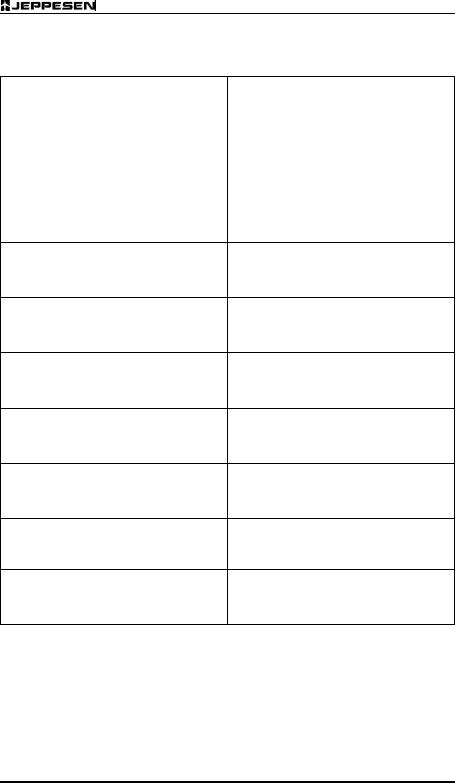
25 FEB 05 |
METEOROLOGY |
35 |
METEOROLOGICAL SERVICE FOR INTERNATIONAL AIR NAVIGATION -- ANNEX 3
APPENDIX 1. MODEL SN – NOTATIONS USED IN FLIGHT DOCUMENTATION
1 SYMBOLS FOR SIGNIFICANT WEATHER
Thunderstorms |
Drizzle |
|
Tropical cyclone |
Rain |
|
Severe squall line* |
Snow |
|
Moderate turbulence |
Shower |
Hail |
Severe turbulence |
Widespread blowing snow |
|
Mountain waves |
Severe sand or dust haze |
|
Moderate aircraft icing |
Widespread sandstorm or duststorm |
|
Severe aircraft icing |
Widespread haze |
|
Widespread fog |
Widespread mist |
|
Radioactive materials in the atmosphere |
|
|
** |
Widespread smoke |
|
© JEPPESEN SANDERSON, INC., 1999, 2005. ALL RIGHTS RESERVED.
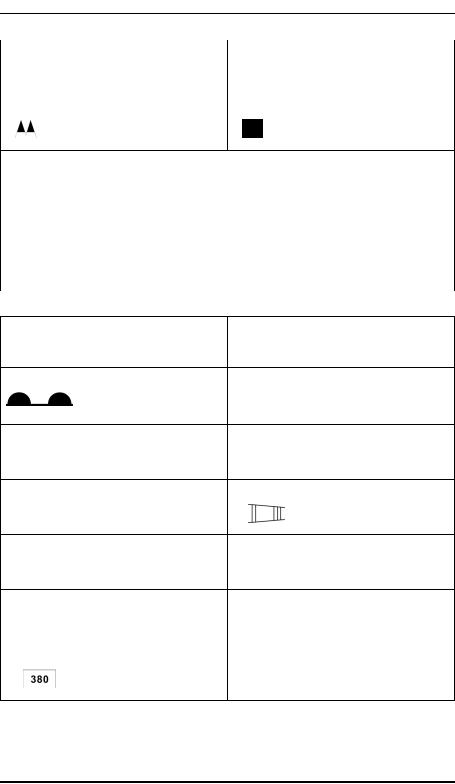
36 |
METEOROLOGY |
25 FEB 05 |
METEOROLOGICAL SERVICE FOR INTERNATIONAL AIR NAVIGATION -- ANNEX 3
Volcanic eruption *** |
Freezing precipitation **** |
Mountain obscuration |
Visible ash cloud ***** |
*In flight documentation for flights operating up to FL 100, this symbol refers to “squall line”.
**The following information should be included at the side of the chart: radioactive materials symbol; Latitude/longitude of accident site; Date and time of accident; check NOTAM for further information.
***The following information should be included at the side of the chart: Volcanic eruption symbol; Name and international number of volcano (if known); Latitude/longitude; Date and time of the first eruption (if known)
Check SIGMETs and NOTAM or ASHTAM for volcanic ash.
****This symbol does not refer to icing due to precipitation coming into contact with an aircraft which is at a very low temperature.
*****Visible ash cloud symbol applies only to model VAG not to SIGWX charts.
NOTE: Height indications between which phenomena are expected, top above base as per chart legend.
2 FRONTS AND CONVERGENCE ZONES AND OTHER SYMBOLS USED
Cold front at the surface
Warm front at the surface
Occluded front at the surface
Quasi-stationary front at the surface
Tropopause high
Tropopause low
Tropopause level
Position, speed and level of max. wind
Convergence line
Freezing level
Intertropical convergence zone
State of the sea
Sea surface temperature
Widespread strong surface wind *
© JEPPESEN SANDERSON, INC., 1999, 2005. ALL RIGHTS RESERVED.
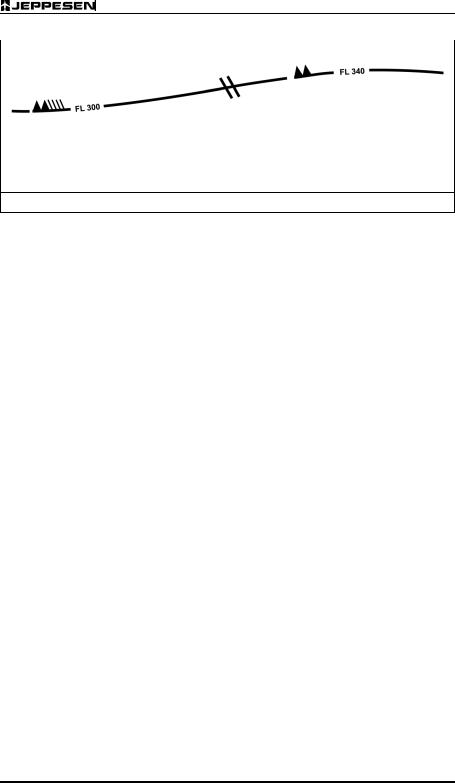
25 FEB 05 |
METEOROLOGY |
37 |
METEOROLOGICAL SERVICE FOR INTERNATIONAL AIR NAVIGATION -- ANNEX 3
Wind arrows indicate the maximum wind in jet and the flight level at which it occurs. Significant changes (speed of 20 knots or more, 3,000 ft (less if practicable) in flight level) are marked by the double bar. In the example, at the double bar the wind speed is 225 km/h - 120 kt.
The heavy line delineating the jet axis begins/ends at the points where a wind speed of 150 km/h - 80 kt is forecast.
* This symbol refers to widespread surface wind speeds exceeding 60 km/h (30 kt).
3 ABBREVIATIONS USED TO DESCRIBE CLOUDS
3.1 |
TYPE |
|
|
CI = Cirrus |
AS = Altostratus |
ST = Stratus |
|
CC = Cirrocumulus |
NS = Nimbostratus |
CU = Cumulus |
|
CS = Cirrostratus |
SC = Stratocumulus |
CB = Cumulonimbus |
|
AC = Altocumulus |
|
|
|
3.2 |
AMOUNT |
|
|
Clouds except CB:
SKC = sky clear (0/8ths)
FEW = few (1/8th to 2/8ths)
SCT = scattered (3/8th to 4/8ths)
BKN = broken (5/8ths to 7/8ths)
OVC = overcast (8/8ths)
CB only:
ISOL = individual CBs (isolated)
OCNL = well separated CBs (occasional)
FRQ = CBs with little or no separation (frequent)
EMBD = CBs embedded in layers of other clouds or concealed by haze (embedded)
3.3HEIGHTS
Heights are indicated on SWH and SWM in flight levels (FL), top over base.
When XXX is used, tops or bases are outside the layer of the atmosphere to which the chart applies. In SWL (low level) significant weather charts:
a.Heights are indicated as altitudes above mean sea level;
b.The abbreviation SFC is used to indicate ground level.
4 DEPICTING OF LINES AND SYSTEMS ON SPECIFIC CHARTS
4.1SWH AND SWM — SIGNIFICANT WEATHER CHARTS (HIGH AND MEDIUM)
Scalloped line |
= |
demarcation of areas of significant weather |
Heavy broken line |
= |
delineation of area of CAT |
© JEPPESEN SANDERSON, INC., 1999, 2005. ALL RIGHTS RESERVED.

38 |
METEOROLOGY |
25 FEB 05 |
METEOROLOGICAL SERVICE FOR INTERNATIONAL AIR NAVIGATION -- ANNEX 3
Heavy solid line interrupted by wind arrow and flight level
Figures on arrows
Flight levels inside small rectangles
=position of jet stream axis with indication of wind direction, speed in kt or km/h and height in flight levels. The vertical extent of the jet stream is indicated (in flight levels) below the flight level, e.g. FL270 accompanied by +20/-30 indicates that the height of the jet extends from FL240 to FL290.
=speed in kt or km/h of movement of frontal system
=height in flight levels of tropopause at spot locations; e.g.,  . Low and High points of the tropopause topography are indicated by the letters L or H respectively inside a pentagon with the height in flight levels.
. Low and High points of the tropopause topography are indicated by the letters L or H respectively inside a pentagon with the height in flight levels.
4.2SWL — SIGNIFICANT WEATHER CHART (LOW LEVEL)
X |
= position of pressure centres given in hectopascals; |
|
L |
= centre of low pressure; |
|
H |
= centre of high pressure; |
|
Scalloped lines |
= demarcation of area of significant weather |
|
Dashed lines |
= altitude of 0°C isotherm in feet (hectofeet) or metres |
|
|
NOTE: 0°C level may also be indicated by ; |
i.e., 0°C level is at an |
|
altitude of 6,000 ft. |
|
Figures on arrows |
= speed in kt or km/h of movement of frontal systems, depressions or anticyclones |
|
Figure inside the |
= total wave height in feet or metres |
|
state of the sea |
|
|
symbol |
|
|
Figure inside the sea |
= sea surface temperature in °C |
|
surface temperature |
|
|
symbol |
|
|
Figures inside the |
= wind in kt or km/h |
|
strong surface wind |
|
|
symbol |
|
|
4.3ARROWS AND FEATHERS
Arrows indicate direction. Number of pennants and/or feathers correspond to speed.
EXAMPLE:
270° / 115 kt (equivalent to 213 km/h)
A pennant corresponds to 50 kt or 93 km/h;
A feather corresponds to 10 kt or 18 km/h;
A half-feather corresponds to 5 kt or 9 km/h.
© JEPPESEN SANDERSON, INC., 1999, 2005. ALL RIGHTS RESERVED.

4 MAR 05 |
METEOROLOGY |
39 |
METEOROLOGICAL SERVICE FOR INTERNATIONAL AIR NAVIGATION - ANNEX 3
APPENDIX 2 - TECHNICAL SPECIFICATIONS RELATED TO WORLD AREA FORECAST SYSTEM AND METEOROLOGICAL OFFICES
Table A2-1. Template for advisory message for volcanic ash
Key: |
M |
= |
inclusion mandatory, part of every message; |
0= inclusion optional;
== a double line indicates that the text following it should be placed on the subsequent line
NOTE 1: The ranges and resolutions for the numerical elements included in advisory messages for volcanic ash are shown in Appendix 6, Table A6-4.
NOTE 2: The explanations for the abbreviations can be found in the Procedures for Air Navigation Services - ICAO Abbreviations and Codes (PANS-ABC, Doc 8400).
NOTE 3: Inclusion of a "colon " after each element heading is mandatory.
NOTE 4: The numbers 1 to 18 are included only for clarity and they are not part of the advisory message, as shown in the example.
NOTE:
1.Use abbreviations for months of the year from the PANS-ABC (Doc 8400), for example, "JAN".
2.International Association of Volcanology and Chemistry of the Earth's Interior (IAVCEI).
3.Up to 4 selected layers.
4.If ash reported (e.g. AIREP) but not identifiable from satellite data.
© JEPPESEN SANDERSON, INC., 1999, 2005. ALL RIGHTS RESERVED.
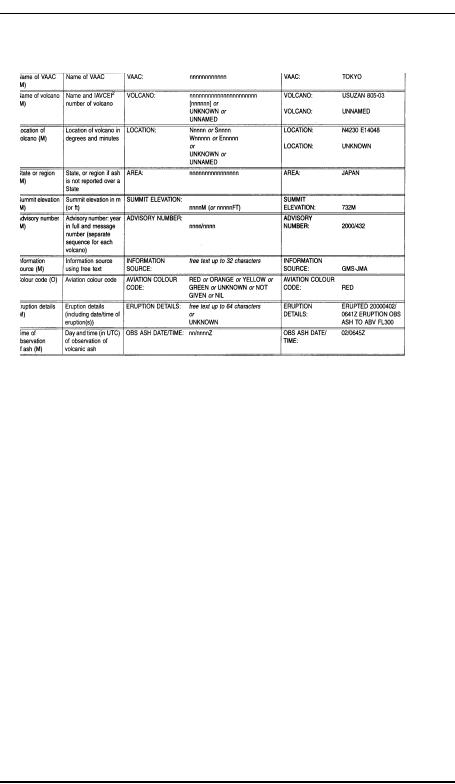
40 |
METEOROLOGY |
4 MAR 05 |
METEOROLOGICAL SERVICE FOR INTERNATIONAL AIR NAVIGATION - ANNEX 3
Table A2-1 - Template for advisory message for volcanic ash
© JEPPESEN SANDERSON, INC., 1999, 2005. ALL RIGHTS RESERVED.
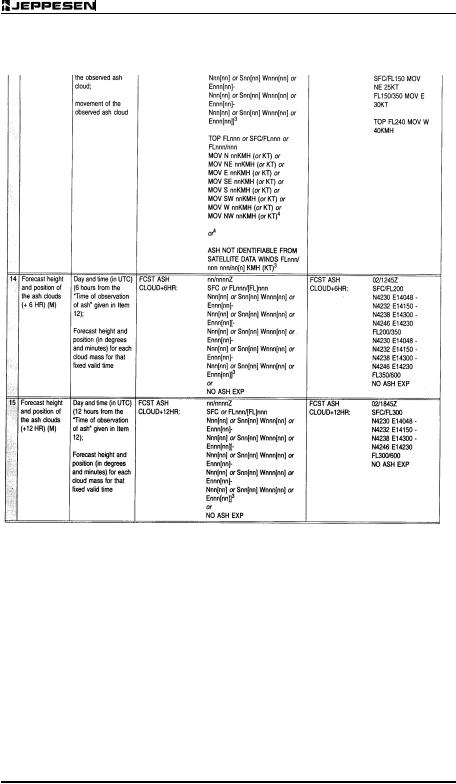
25 FEB 05 |
METEOROLOGY |
41 |
METEOROLOGICAL SERVICE FOR INTERNATIONAL AIR NAVIGATION - ANNEX 3
 Table A2-1 cont’d
Table A2-1 cont’d
© JEPPESEN SANDERSON, INC., 1999, 2005. ALL RIGHTS RESERVED.
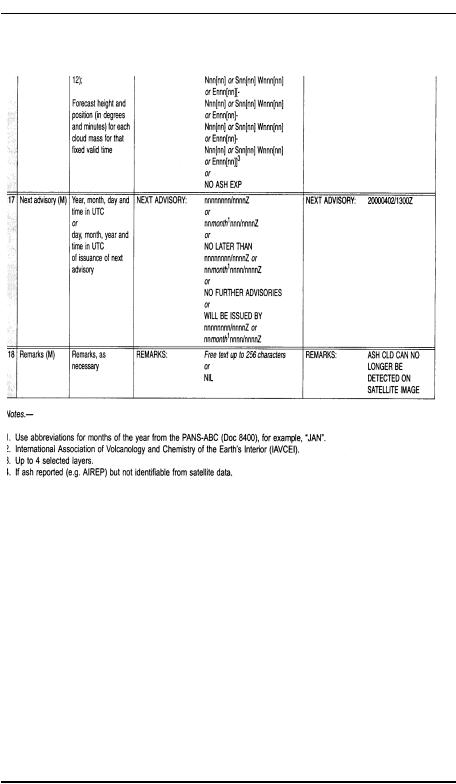
42 |
METEOROLOGY |
25 FEB 05 |
METEOROLOGICAL SERVICE FOR INTERNATIONAL AIR NAVIGATION - ANNEX 3
 Table A2-1 cont’d
Table A2-1 cont’d
© JEPPESEN SANDERSON, INC., 1999, 2005. ALL RIGHTS RESERVED.

25 FEB 05 |
METEOROLOGY |
43 |
METEOROLOGICAL SERVICE FOR INTERNATIONAL AIR NAVIGATION - ANNEX 3 |
|
|
Example A2-1. Advisory message for volcanic ash |
|
|
VOLCANIC ASH ADVISORY |
|
|
ISSUED: |
20000402/0700Z |
|
VAAC: |
TOKYO |
|
VOLCANO: |
USUZAN 805-03 |
|
LOCATION: |
N4230 E14048 |
|
AREA: |
JAPAN |
|
SUMMIT ELEVATION: |
732M |
|
ADVISORY NUMBER: |
2000/432 |
|
INFORMATION SOURCE: |
GMS JMA |
|
AVIATION COLOUR CODE: |
RED |
|
ERUPTION DETAILS: |
ERUPTED 20000402/0614Z ERUPTION OBS ASH TO ABV FL300 |
|
OBS ASH DATE/TIME: |
02/0645Z |
|
OBS ASH CLD: |
FL150/350 N4230 E14048 - N4300 E14130 - N4246 E14230 - N4232 |
|
|
E14150 -N4230 E14048 SFC/FL150 MOV NE 25KT FL150/350 MOV |
|
|
E 30 KT |
|
FCST ASH CLD + 6 HR: |
02/1245Z SFC/FL200 N4230 E14048 - N4232 E14150 - N4238 |
|
|
E14300 - N4246 E14230 FL200/350 N4230 E14048 - N4232 E14150 |
|
|
N4238 E14300 - N4246 E14230 FL350/600 NO ASH EXP |
|
FCST ASH CLD + 12 HR: |
02/1845Z SFC/FL300 N4230 E14048 - N4232 E14150 - N4238 |
|
|
E14300 - N4246 E14230 FL300/600 NO ASH EXP |
|
FCST ASH CLD + 18 HR: |
03/0045Z SFC/FL600 NO ASH EXP |
|
NEXT ADVISORY: |
20000402/1300Z |
|
REMARKS: |
ASH CLD CAN NO LONGER BE DETECTED ON SATELLITE IMAGE |
|
© JEPPESEN SANDERSON, INC., 1999, 2005. ALL RIGHTS RESERVED.

44 |
METEOROLOGY |
25 FEB 05 |
METEOROLOGICAL SERVICE FOR INTERNATIONAL AIR NAVIGATION - ANNEX 3 |
||
|
Table A2-2. Template for advisory message for tropical cyclones |
|
Key: = |
= a double line indicates that the textAbbreviations and Codes (PANS-ABC, Doc 8400). |
|
|
following it should be placed on the subsequent line |
|
NOTE 1: The ranges and resolutions for the numerical elements included in advisory messages for tropical cyclone are shown in Appendix 6, Table A 6-4.
NOTE 2: The explanations for the abbreviations can be found in the Procedures for Air Navigation Services - ICAI Abbreviations and Codes (PANS-ABC, Doc 8400).
NOTE 3: All the elements are mandatory.
NOTE 4: Inclusion of a "colon " after each element heading is mandatory.
NOTE 5: The numbers 1 to 16 are included only for clarity and they are not part of the advisory message, as shown in the example.
© JEPPESEN SANDERSON, INC., 1999, 2005. ALL RIGHTS RESERVED.
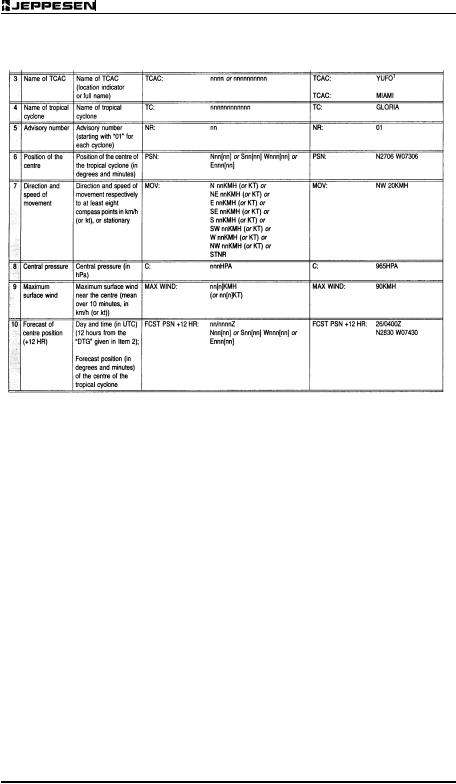
25 FEB 05 |
METEOROLOGY |
45 |
METEOROLOGICAL SERVICE FOR INTERNATIONAL AIR NAVIGATION - ANNEX 3
 Table A2-2
Table A2-2
© JEPPESEN SANDERSON, INC., 1999, 2005. ALL RIGHTS RESERVED.
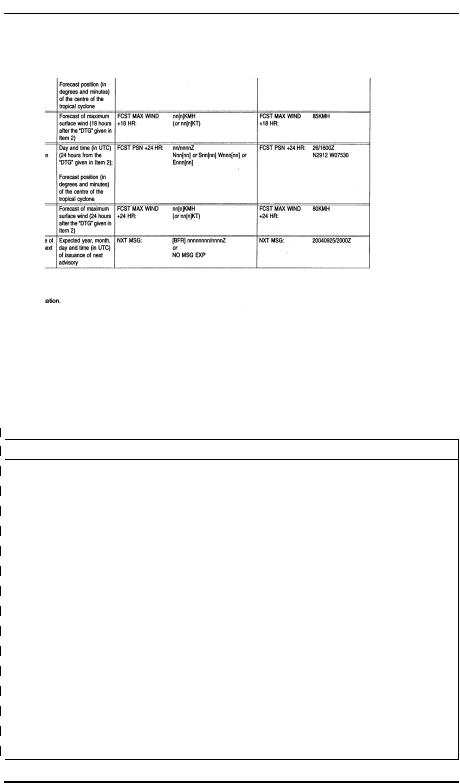
46 |
METEOROLOGY |
25 FEB 05 |
METEOROLOGICAL SERVICE FOR INTERNATIONAL AIR NAVIGATION - ANNEX 3
 Table A2-2 cont’d
Table A2-2 cont’d
Example A2-2. Advisory message for tropical cyclones
TC ADVISORY |
|
DTG: |
19970925/160OZ |
TCAC: |
YUFO |
TC: |
GLORIA |
NR: |
01 |
PSN: |
N2706 W07306 |
MOV: |
NW 20KMH |
C: |
965HPA |
MAX WIND: |
90KMH |
FCST PSN + 12 HR: |
26/040OZ N2830 W07430 |
FCST MAX WIND + 12 HR: |
90KMH |
FCST PSN + 18 HR: |
2611000Z N2852 W07500 |
FCST MAX WIND + 18 HR: |
85KMH |
FCST PSN + 24 HR: |
26/160OZ N2912 W07530 |
FCST MAX WIND + 24 HR: |
80KMH |
NXT MSG: |
19970925/2000Z |
© JEPPESEN SANDERSON, INC., 1999, 2005. ALL RIGHTS RESERVED.
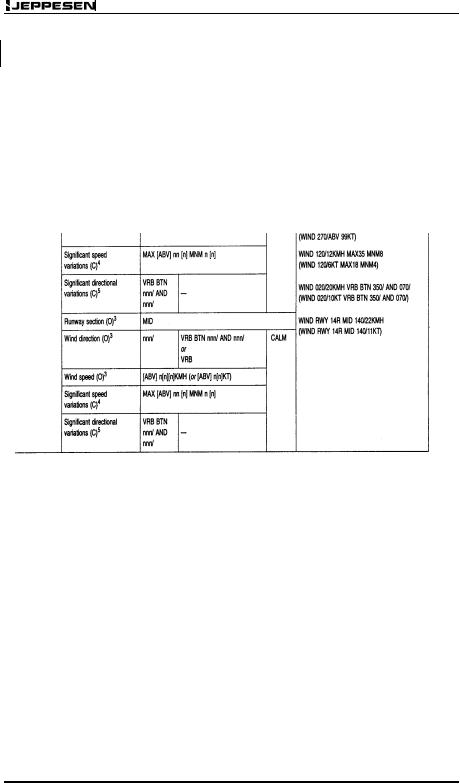
4 MAR 05 |
METEOROLOGY |
47 |
METEOROLOGICAL INFORMATION FOR INTERNATIONAL AIR NAVIGATION - ANNEX 3
APPENDIX 3 - TECHNICAL SPECIFICATIONS RELATED TO METEOROLOGICAL OBSERVATIONS AND REPORTS
Table A3-1 - Template for the local routine (MET REPORT) and local (SPECIAL) reports
Key: |
M |
= |
inclusion mandatory, part of every message |
|
C |
= |
inclusion conditional, dependent on meteorological condition |
|
0 |
= |
inclusion optional |
NOTE 1: The ranges and resolutions for the numerical elements included in the local routine and special reports are shown in Table A3-4 of this appendix.
NOTE 2: The explanations for the abbreviations used can be found in the Procedures for Air Navigation Services - ICAO Abbreviations and Codes (PANS-ABC, Doc 8400).
© JEPPESEN SANDERSON, INC., 2005. ALL RIGHTS RESERVED.
